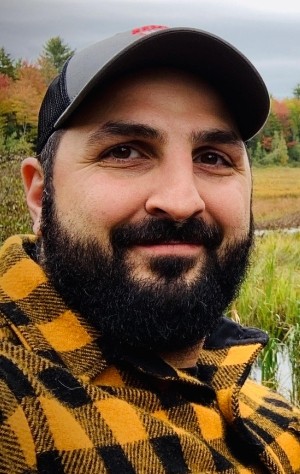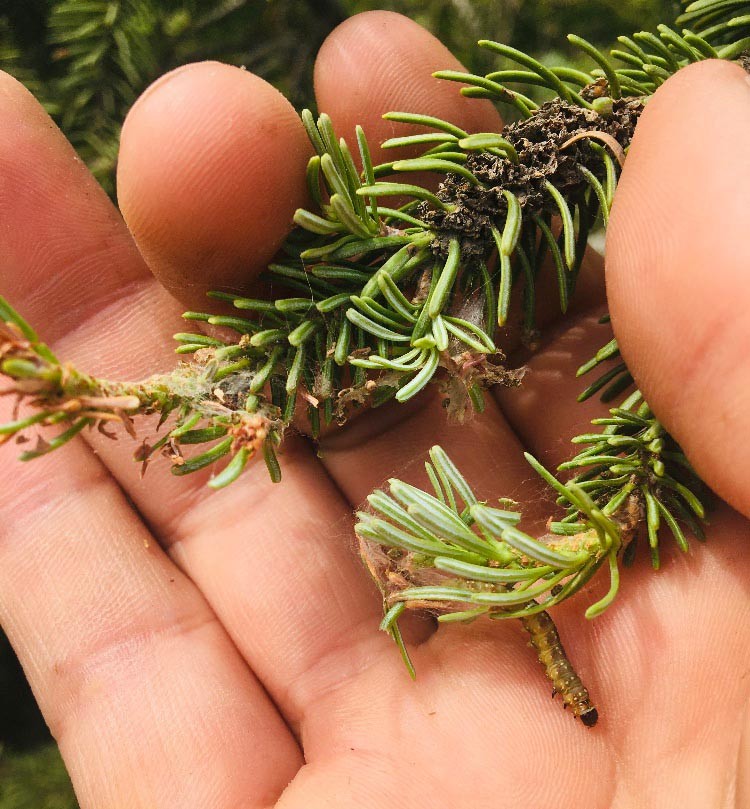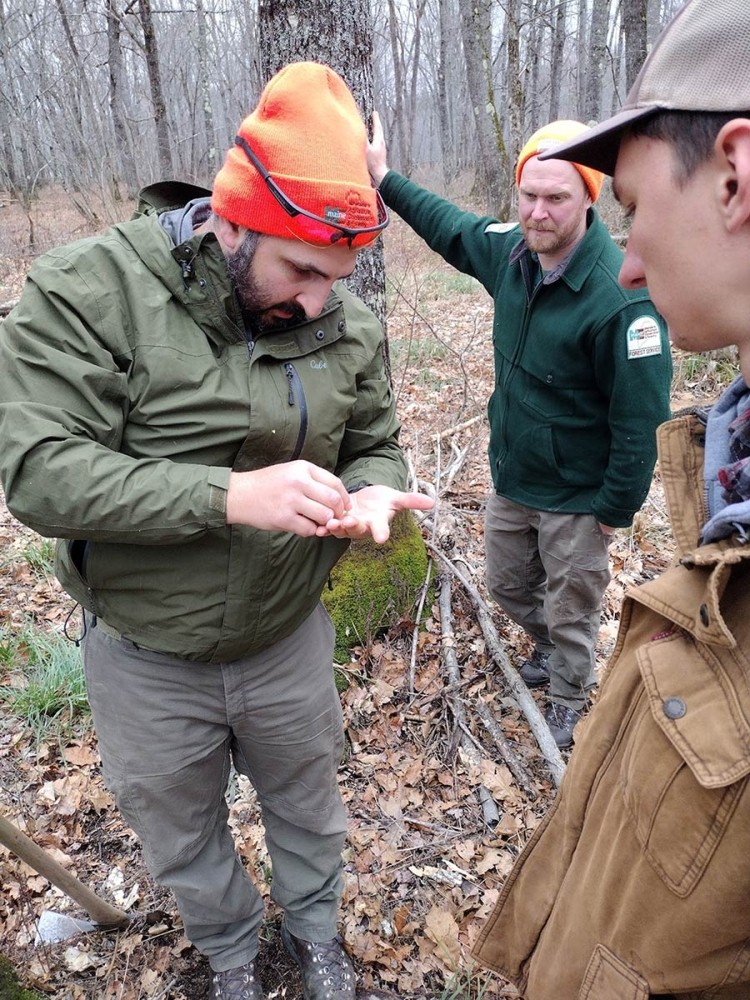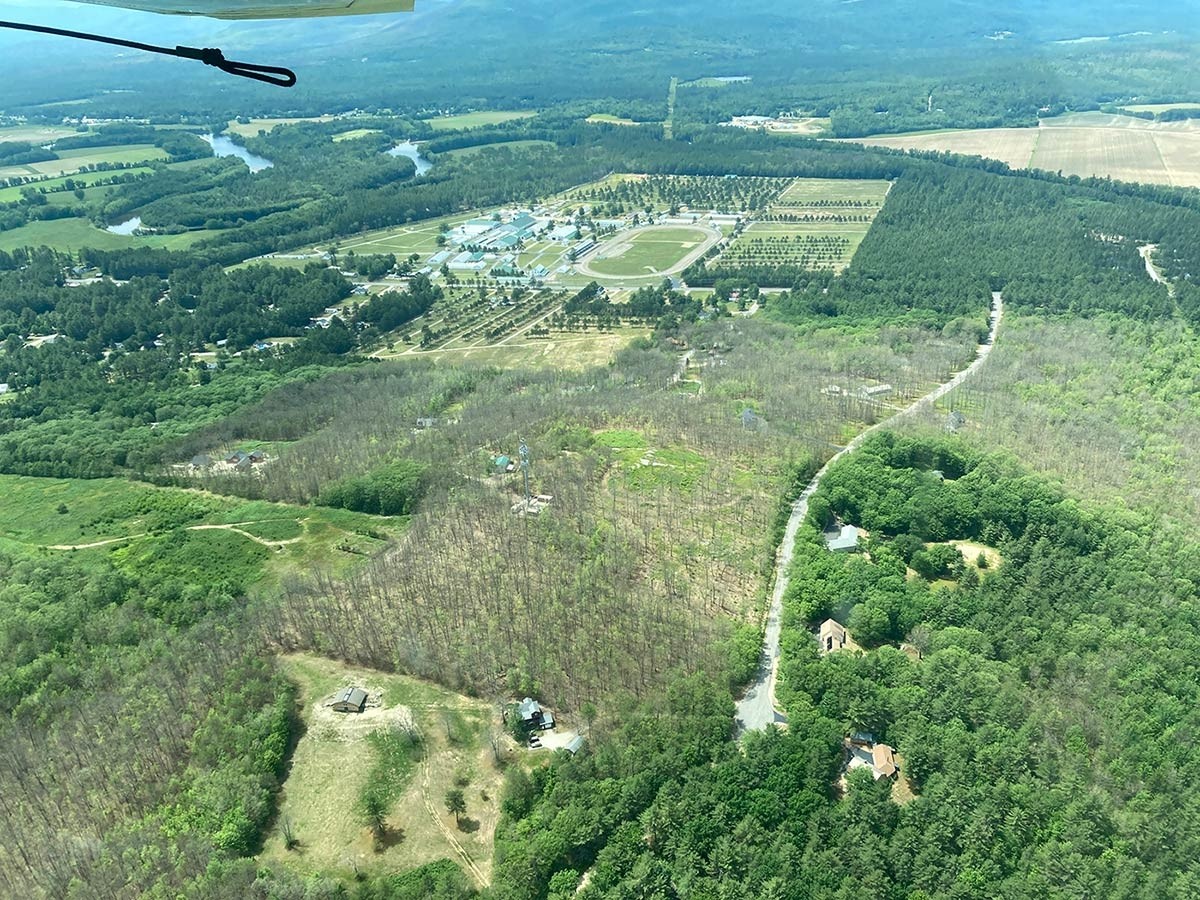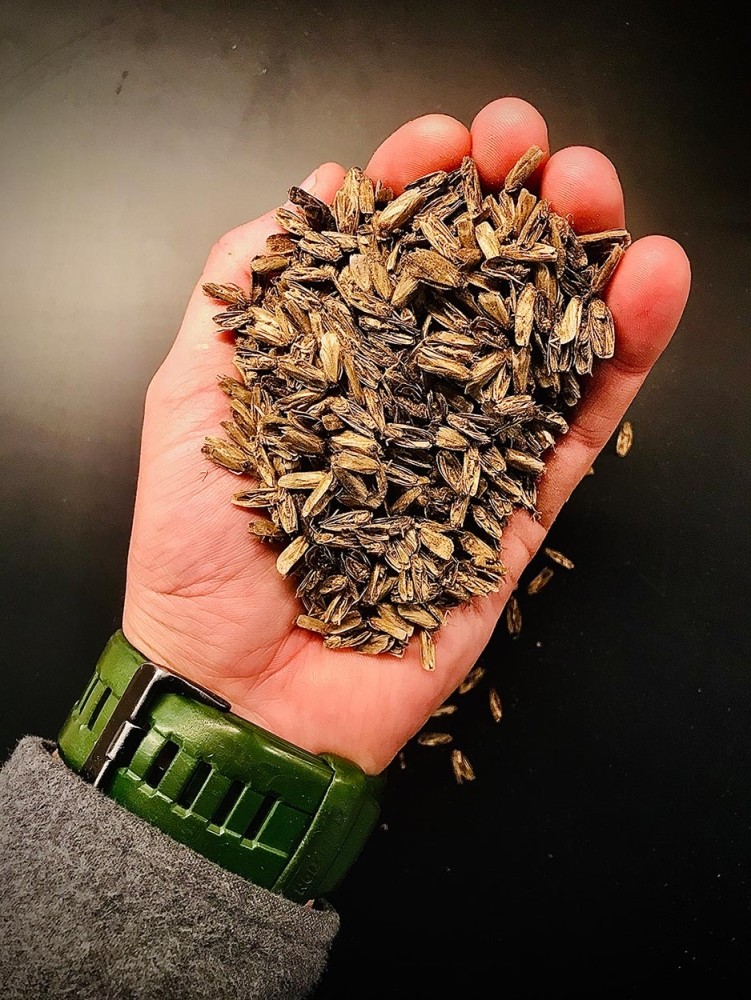Mike Parisio has always been fascinated by the natural world. After earning a bachelor’s degree in environmental science, he pursued a master’s degree – and, eventually, a career – in forest entomology. He worked as a forest health specialist in northern Minnesota and then in Vermont before joining the Maine Forest Service in 2019 as a forest entomologist. Much of his work is focused on invasive species, including the emerald ash borer. Mike lives with his girlfriend and their two dogs in Pittston, where they maintain a large vegetable garden, keep chickens and bees, and have recently planted fruit trees.
I grew up New York State in the Catskill Mountains, in the tiny town of Olivebridge. We had a heavily forested 5-acre property. I think I climbed every tree that’s climbable on that property as a kid. We also did a lot of hiking in the Catskill Forest Preserve. The historic town center is actually under a reservoir that provides drinking water for New York City. When the water level is low enough, you can still see some of the old stone foundations on the bottom of the reservoir. It’s a sore point for some people, but we like to think it’s some of the best drinking water there is. And some people say that’s why the New York City pizza is so good, because of that Catskill water – they can make the dough perfect.
We were the typical family that vacationed in Maine. My parents have been coming up since the ’80s, and they honeymooned in Maine. They introduced us to Maine. I remember being obsessed with the geology on Mount Desert Island – it was just unlike anything I’d ever seen. We’d hike every day when we came up. Being there with both mountains and ocean, it was a paradise for an outdoors kid. That’s one of my greatest joys of being here now – through work and also on my personal time, just trying to explore every corner and see how much the state has to offer. It never disappoints, really.
I don’t really know that I had much of a career plan when I showed up at college. I went to SUNY Binghamton, in the southern tier of New York state. My dad is a geologist and soil scientist. My uncle is an environmental educator. My cousin, who I always looked up to as a kid, is a wetland ecologist. I thought I was going to branch out and do something different than the family tradition. But then I had to take an intro to environmental science course with Dr. (Richard) Andrus, and as soon as I went through that, I knew where I belonged. I ended up with a general environmental science degree.
I was not destined to be a career entomologist from the time I was a kid. I think all branches of the natural sciences are pretty fascinating. Although, as a kid, I did make up this club, called the Creepy Crawler Club. I had little plastic molds of insects, and I used to hide them in places, and all my relatives would pretend to be scared out of their minds, and I thought that was the funniest thing in the world. But I was pretty much fascinated with everything outside. I didn’t have a particular affinity for insects. I thought about a wildlife biologist career, or an ornithologist career. There’s a certain practicality to entomology, because not everybody’s interested in it. Once you start, it becomes more interesting as you go. It’s been a rewarding decision for sure.
When I graduated from SUNY Binghamton, that’s when emerald ash borer was really blowing up in New York State. The lower Hudson Valley was one of the epicenters where EAB was introduced into New York State. I was seeing this visible destruction. Every time I’d go home from college, there’d be more and more trees that were dying or dead. I started looking around at grad schools, and I discovered there was an entomology program at SUNY ESF in Syracuse. I went up there and met with professor Melissa Fierke. They were doing some field work at the time, and she invited me out with her lab group. That sealed the deal for me. That’s how I ended up in the entomology field. I did all my graduate work on emerald ash borer and some of the biological control components of EAB.
I think “forest entomologist” probably meant a somewhat different thing in the past than it does now. If you look through the old literature from the Maine Forest Service, there was a lot of interesting work being done on things that were native to Maine. The biggest things we’re focused on now are invasive insects and native pests that are affecting humans. Our work now is really focused on being an information source. The major pests we work on are emerald ash borer, hemlock woolly adelgid, browntail moth, spongy moth, spruce budworm, and a whole variety of important pathogens – beech leaf disease, Dutch elm disease, we’re on the lookout for oak wilt. It used to be somewhat of a short list. But unfortunately, that list is continually growing. We’re constantly adding programs to our lab unit because things need attention.
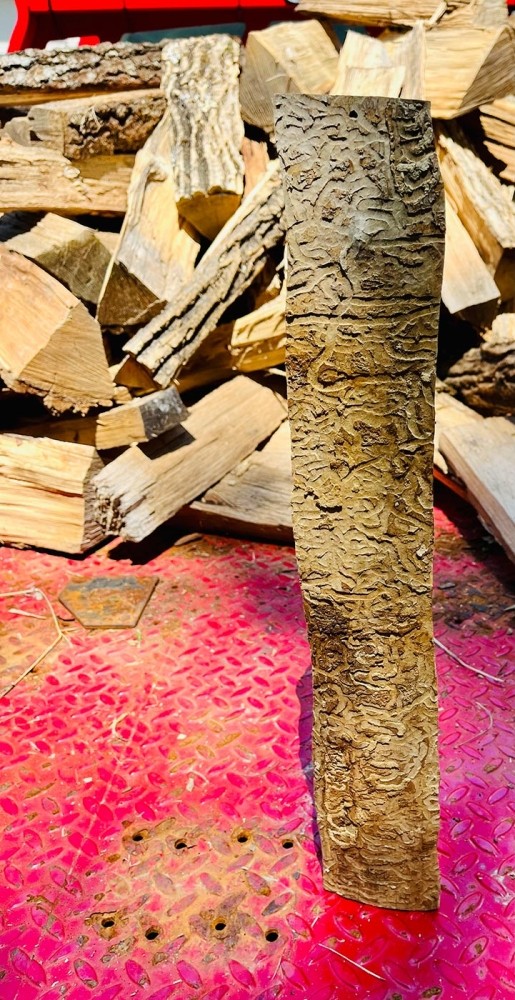
We don’t do that much hands-on management. We’re really there as an information resource and to tell people how to do the management. We’re the people at the end of the phone line when people call and they have a problem – either they’re trying to identify a pest or they know what it is and they need to know what to do about it. There’s a huge amount of public interaction. With EAB, for example, we do a ton of outreach about firewood, because that’s one of the ways that EAB is transported – in infested firewood. We’re doing a ton of monitoring for EAB – our purple prism trap program, our green funnel trap program, our girdled trap program, visual survey, and enlisting the public in visual surveys. Those are some of our annual monitoring projects. That’s how we keep an eye on the spread.
We’re working on a biological control program. That involves releasing parasitoid wasps from the native range of EAB. We’re one of many states participating in this national campaign to try to get some control on the landscape. It helps not eliminate, but manage EAB populations. It’s looking at that future forest and what that will look like when EAB has killed most of the ash in Maine. Unfortunately, we have had that situation with a lot of tree species – chestnut, elm – is ash going to be that next one, where you find a small tree occasionally in the woods? There’s also the urban component of EAB, where the Community Forestry Program is helping people with inventories, planning removals. We recommend treatment and provide a list of registered pesticide applicators or arborists that can help with X, Y, and Z.
One of the tools we use is aerial survey – getting up in an airplane, looking at stuff and mapping it. We’re basically looking for any damage, any disturbance in the canopy that tells us that there’s something going on. There’s a certain set of insect or disease issues we know we’re going to see, so we try to keep track of those and document them every year. It’s also looking for new things that we’re not aware of. There’s a lot of remote areas in Maine where there are not even logging roads – and even where there are roads, you can drive all the roads in that area and map what you’re seeing from the ground, but you really need that aerial perspective sometimes. One example is the spongy moth outbreak in western Maine – there have been multiple years with over 50,000 acres of damage. The only way you can really appreciate that is from the air.
Beyond the invasive species, the climate issues are also really problematic for our forests. With the spongy moth outbreak on the New Hampshire-Maine border – that was co-occurring with multiple years of drought, then you have severe defoliation. The trees were really suffering. Then this year, we have a frost in late May that’s absolutely destructive to the oaks across hundreds of thousands of acres in both Maine and New Hampshire, probably. That’s another defoliation event. This summer it’s been cold and wet, so a lot of the caterpillars have died, but you still have the loss of leaves because of that frost. We’re seeing a lot of bizarre tree behavior this year. We rarely get this much moisture. And now it’s going to get hot – is it going to get dry again, too? The normal cycles just aren’t really holding up anymore, and it’s a lot of stress for things that are evolved to take advantage of those reliable cycles.
I’ve lived in places that are absolutely destroyed from invasive plants and invasive insects and disease. Entomology doesn’t always receive the most attention, but when you think about what the tourism draw for Maine is – it is our forests, our outdoor recreation. It’s scary when you get out there and see a lot of dead trees. When I go back to see my parents in New York, I drive the Mass Turnpike, and all the ash is dead. Most of the oak is dead. When you’re programmed to see this stuff like we are, you can’t ever unsee it – anywhere you go.
Maine is on the verge of a lot of these problems. We’re getting to a tipping point. But we’ve been spared a little bit longer based on geographic location and population. People are getting more aware, but it is still hard to make some of these things resonate, unless it’s part of your daily life. A lot of these things come and go, but a lot of them are here to stay. Some of these pests are cyclical. Spongy moth is hopefully declining in those outbreak areas, but we’re going to have a lot of dead trees around. There’s a long-lasting effect, with invasive plants taking advantage of open canopies from tree die off. You go to New York, it’s all barberry and bittersweet underneath. One bad event makes an opportunity for another bad event. It’s a spiral sometimes.
On the plus side, Maine has some really good forest regeneration and grows trees well. Hopefully a lot of these things can correct themselves, or we’ll get some help from Mother Nature.
I’ve lived in Maine for four years, and I’m still in honeymoon mode. I love getting outside. I’m a food person, so I always like to find a cool location to go for a hike, then get a meal or have a beer – the brewery scene is great. I do some woodworking, and we’re constantly working on projects around the house. And people always want to visit when you live in Maine, so we do a fair amount of tour guiding.


